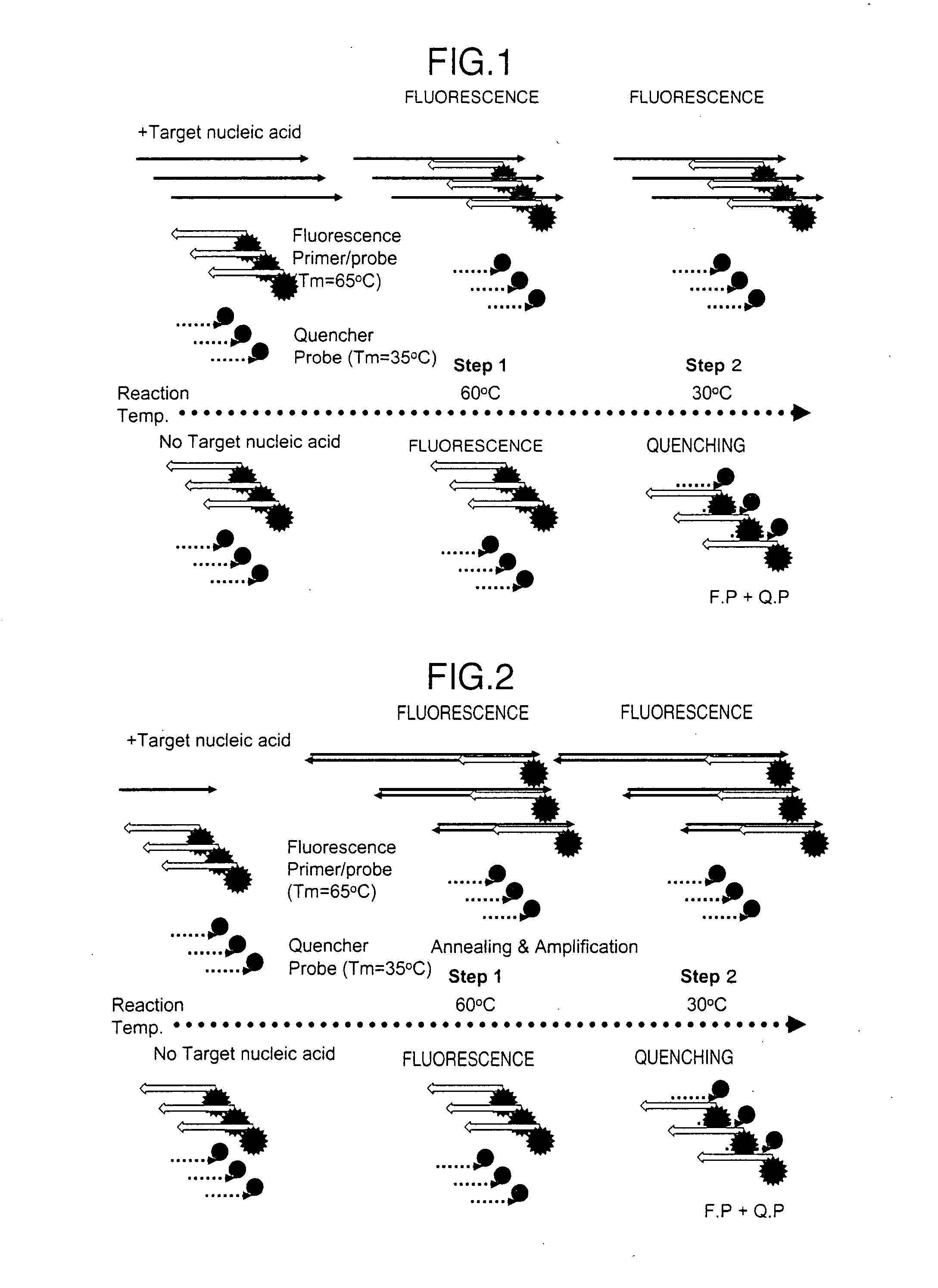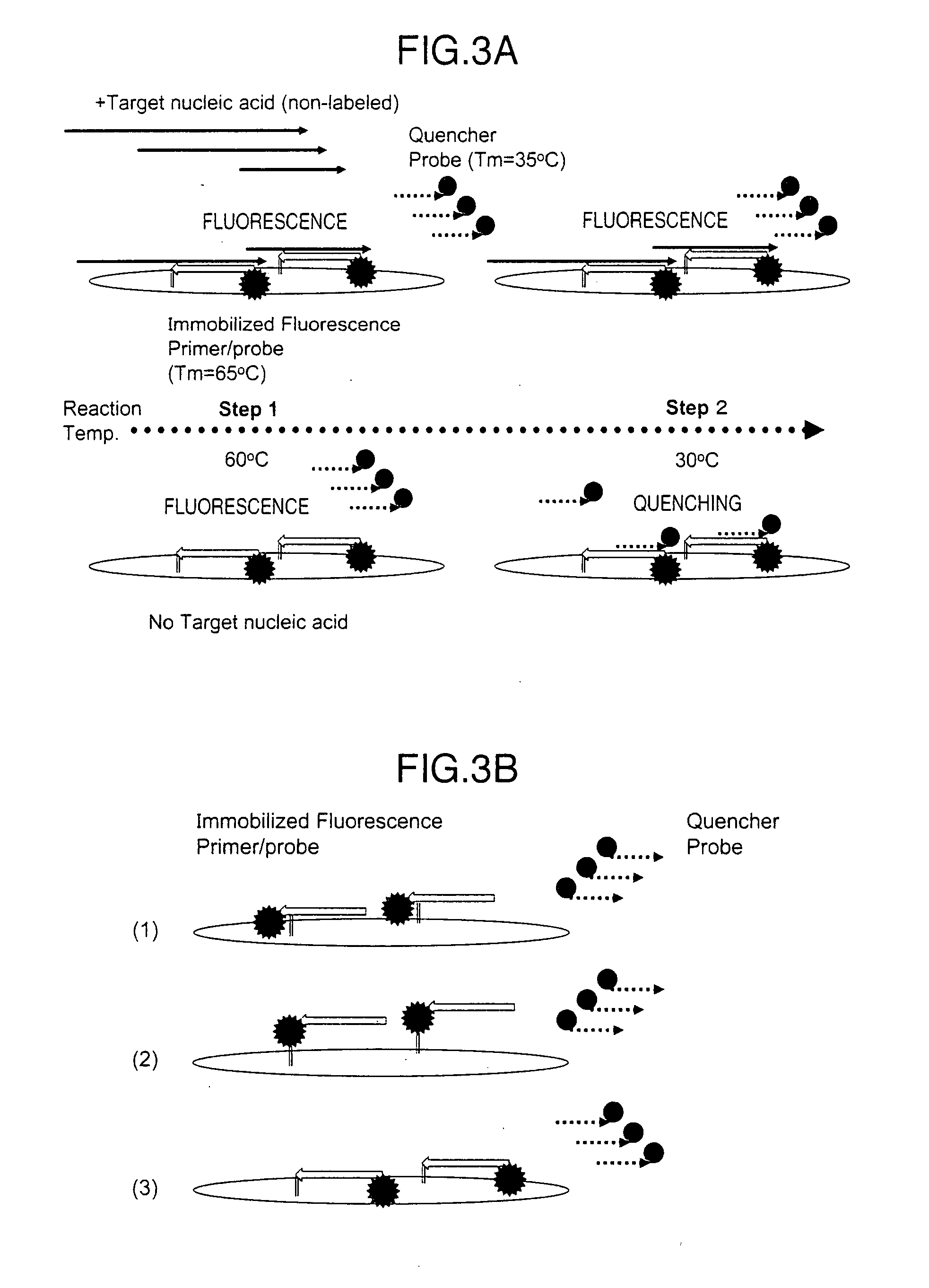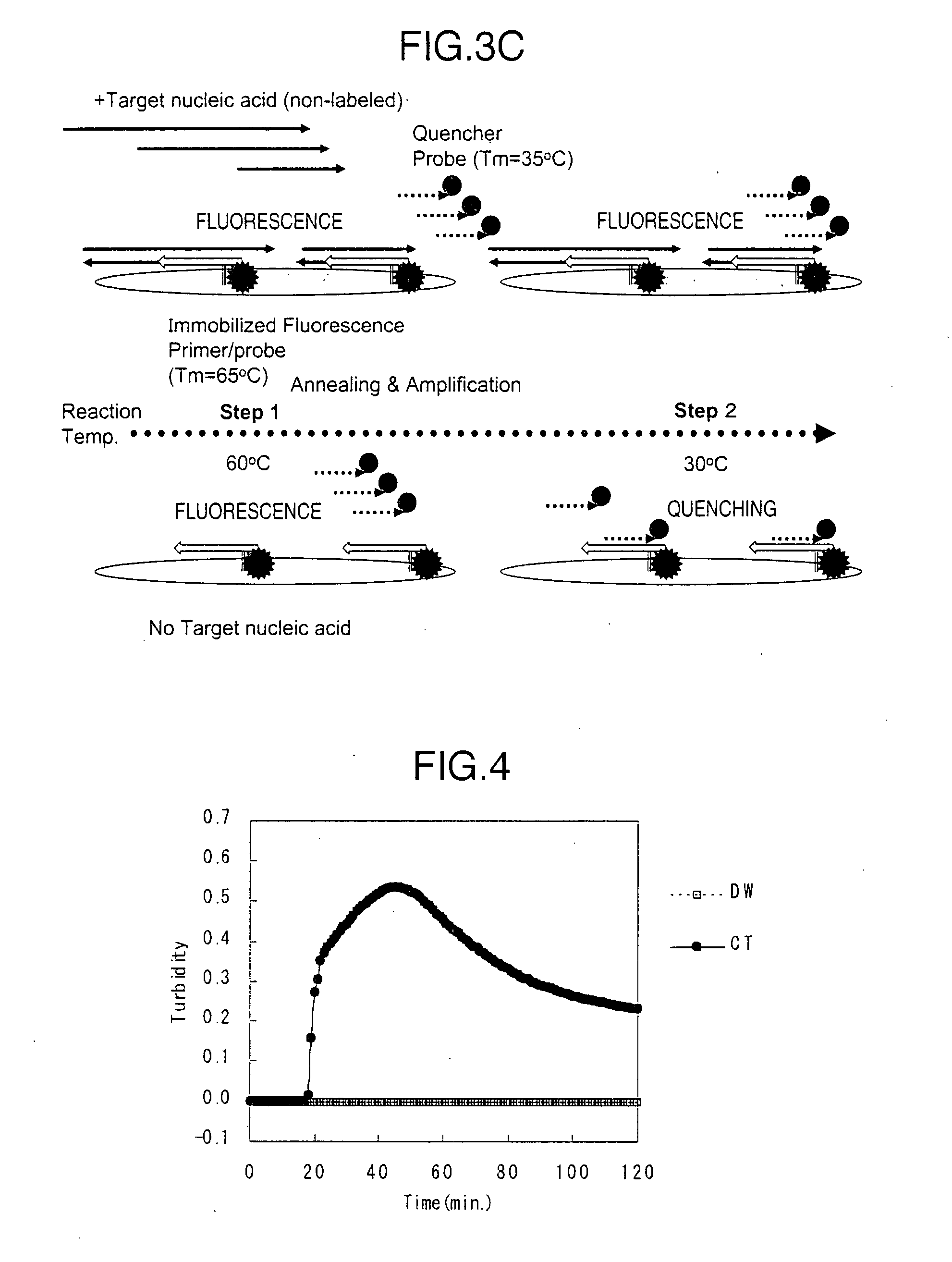Method for detecting target nucleic acid
a nucleic acid and target technology, applied in the field of target nucleic acid detection, can solve the problems of requiring expensive sensitive equipment, risk of causing contamination between samples or experimental environments, etc., and achieve the effects of detecting target nucleic acids more conveniently and inexpensively, avoiding contamination danger, and relatively convenient temperature control and free from necessary precision
- Summary
- Abstract
- Description
- Claims
- Application Information
AI Technical Summary
Benefits of technology
Problems solved by technology
Method used
Image
Examples
example 2
The Case of Quencher-Labeled Probe is Added after LAMP Amplification
(1) Assay Template
[0163]A portion (SEQ ID NO: 21) of a Chlamydia trachomatis cryptic plasmid region was subcloned as a template for assay to prepare plasmid DNAs (hereinafter, referred to as CT plasmids).
(2) Synthesis of Primer, Fluorophore-Labeled Primer / Probe, and Quencher-Labeled Probe
[0164]Primers were designed to target the Chlamydia trachomatis cryptic plasmid region and have no cross-reactivity with related bacteria. Of the designed primers, LB 5′-terminally fluorescently labeled with FAM was used as a fluorophore-labeled primer / probe, while its complementary strand 3′-terminally labeled with BHQ1 was used as a quencher-labeled probe. Primer synthesis was outsourced to Operon Biotechnologies Inc. The synthesis of the fluorophore-labeled primer and the quencher-labeled probes was outsourced to Japan Bio Services Co., Ltd.
Chlamydia trachomatis primer>CT-FIP: (SEQ ID NO: 1)5′-CAAGCAGGACTACAAGCTGCAGCGTTTGTACTCCGT...
example 3
Simultaneous Amplification and Detection Method of Chlamydia Trachomatis and Neisseria gonorrhoeae Using LAMP
(1) Assay Template
[0190]A portion (SEQ ID NO: 21) of a Chlamydia trachomatis cryptic plasmid region was subcloned as an internal standard template to prepare plasmid DNAs (hereinafter, referred to as CT plasmids). Also, a portion (SEQ ID NO: 32) of a Neisseria gonorrhoeae mtrA region was subcloned as a target nucleic acid template to prepare plasmid DNAs (hereinafter, referred to as NG plasmids).
(2) Synthesis of Chlamydia trachomatis Primer, TAMRA-Labeled Loop Primer (Fluorophore-Labeled Primer / Probe), and BHQ2-Labeled Quenching Probe (Quencher-Labeled Probe)
[0191]Primers were designed to target the Chlamydia trachomatis cryptic plasmid region and have no cross-reactivity with related bacteria. Primer synthesis was outsourced to Operon Biotechnologies Inc. The synthesis of the TAMRA-labeled loop primer and the BHQ2-labeled quenching probe was outsourced to Japan Bio Services ...
example 4
Multiple-Item Simultaneous Amplification and Detection of Chlamydia Trachomatis, Neisseria gonorrhoeae, and Artificial Nucleic Acid
(1) Assay Template
[0216]A portion (SEQ ID NO: 21) of a Chlamydia trachomatis cryptic plasmid region was subcloned as a template for assay to prepare plasmid DNAs (hereinafter, referred to as CT plasmids). Also, a portion (SEQ ID NO: 32) of a Neisseria gonorrhoeae mtrA region was subcloned as a template for assay to prepare plasmid DNAs (hereinafter, referred to as NG plasmids). Further, an artificial nucleic acid sequence (SEQ ID NO: 33) was subcloned as a template for assay to prepare plasmid DNAs (hereinafter, referred to as ARITA2 plasmids).
(2) Synthesis of Primer, Fluorophore-Labeled Primer / Probe, and Quencher-Labeled Probe
[0217]Primers for LAMP reaction were designed to target the Chlamydia trachomatis cryptic plasmid region, the Neisseria gonorrhoeae mtrA region, or the artificial nucleic acid sequence and have no cross-reactivity with related bact...
PUM
| Property | Measurement | Unit |
|---|---|---|
| constant temperature | aaaaa | aaaaa |
| temperature | aaaaa | aaaaa |
| Tm | aaaaa | aaaaa |
Abstract
Description
Claims
Application Information
 Login to View More
Login to View More - R&D
- Intellectual Property
- Life Sciences
- Materials
- Tech Scout
- Unparalleled Data Quality
- Higher Quality Content
- 60% Fewer Hallucinations
Browse by: Latest US Patents, China's latest patents, Technical Efficacy Thesaurus, Application Domain, Technology Topic, Popular Technical Reports.
© 2025 PatSnap. All rights reserved.Legal|Privacy policy|Modern Slavery Act Transparency Statement|Sitemap|About US| Contact US: help@patsnap.com



